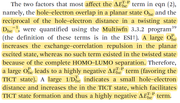Multiwfn forum
Multiwfn official website: http://sobereva.com/multiwfn. Multiwfn forum in Chinese: http://bbs.keinsci.com/wfn
You are not logged in.
- Topics: Active | Unanswered
Pages: 1
#1 Re: Multiwfn and wavefunction analysis » CDA of aromatic organic compounds » 2024-03-31 14:25:29
I had not added geom=connectivity in the input file, which was the reason for the error.
I did the CDA calculations and plotted the fragment MO diagrams. I have attached the diagrams for alpha (left side) and beta (right side) electrons. However, I am unable to understand the cause of the differences in these two diagrams. The charge transfer takes place from fragment 2 to fragment 1, and I have flipped the electrons for fragment 1 here.
#2 Re: Multiwfn and wavefunction analysis » CDA of aromatic organic compounds » 2024-03-21 13:32:42
With the input # b3lyp/def2tzvp nosymm
#3 Re: Multiwfn and wavefunction analysis » CDA of aromatic organic compounds » 2024-03-21 13:24:42
I was doing single point calculation required for CDA analysis. (# b3lyp/def2-tzvp nosymm)
#4 Re: Multiwfn and wavefunction analysis » CDA of aromatic organic compounds » 2024-03-20 15:33:11
When I am running the calculations, I am getting the following error. Please help.
Error: segmentation violation
rax 0000000000000000, rbx ffffffffffffffff, rcx ffffffffffffffff
rdx 0000000000007c6f, rsp 00007fff581275a8, rbp 00007fff58127b20
rsi 000000000000000b, rdi 0000000000007c6f, r8 0000000000000020
r9 00007fff58126cb8, r10 00007fff581269a0, r11 0000000000000202
r12 00007fff58127b68, r13 0000000000000000, r14 0000000000000000
r15 00000000000003e6
/lib64/libpthread.so.0(+0xf5d0) [0x2aaaaced25d0]
/lib64/libc.so.6(kill+0x7) [0x2aaaad4174d7]
/lfs/sware/g16/l9999.exe() [0x43f8f0]
/lfs/sware/g16/l9999.exe() [0x4565b1]
/lfs/sware/g16/l9999.exe() [0x485f37]
/lfs/sware/g16/l9999.exe() [0x47984f]
/lfs/sware/g16/l9999.exe() [0x4705a5]
/lfs/sware/g16/l9999.exe() [0x4250cb]
/lfs/sware/g16/l9999.exe() [0x40de97]
/lfs/sware/g16/l9999.exe() [0x409138]
/lfs/sware/g16/l9999.exe() [0x4048c0]
/lfs/sware/g16/l9999.exe() [0x4047fb]
/lib64/libc.so.6(__libc_start_main+0xf5) [0x2aaaad4033d5]
/lfs/sware/g16/l9999.exe(sched_setaffinity+0xc1) [0x404729]
#5 Re: Multiwfn and wavefunction analysis » CDA of aromatic organic compounds » 2024-02-23 15:19:09
Thank you so much for your kind help Sir.
#6 Re: Multiwfn and wavefunction analysis » CDA of aromatic organic compounds » 2024-02-23 12:52:45
1. So, I do not need to cap hydrogens and proceed with them as open shell fragments.
2. Thank you so much for informing about the choice of basis sets.
3. I'll use the similar input as CH3NH2 [# b3lyp/def2-tzvp nosymm] along with ub3lyp for fragments and b3lyp for the whole system. Is that correct Sir? Should not IOp(3/33=2) be used?
#7 Multiwfn and wavefunction analysis » CDA of aromatic organic compounds » 2024-02-23 07:08:09
- sonalis
- Replies: 11
I wanted to carry out CDA analysis, for which I read sections 3.19 and 4.16. I have some confusions regarding my calculation. The molecule (M) shows charge transfer properties. A part of the structure has a benzene ring connected to a -NMe2. The -NMe2 part acts as the donor (fragment 1) and rest of the aromatic part acts as the acceptor (fragment 2).
1. M is a closed shell molecule. But for fragments 1 and 2, should I use them as open shell or cap each of them with a hydrogen atom to make them closed shell?
2. If I have to use them as closed shell fragments, then can I use restricted B3LYP for all of them?
3. As all of my other calculations for M has been done in B3LYP/6-311+g(d,p) (which is suitable for my molecule after screening), can I use the same for CDA calculations?
4. If yes, is the following input correct (for Gaussian user)?
M (closed shell): #p rb3lyp/6-311+g(d,p) density pop=NO IOp(3/33=1) nosymm
Fragments (if open shell): #p ub3lyp/6-311+g(d,p) density pop=NOAB IOp(3/33=2) nosymm
Fragments (if closed shell): #p rb3lyp/6-311+g(d,p) density pop=NO IOp(3/33=2) nosymm
#8 Re: Quantum Chemistry » Calculating energies of FC and relaxed first excited state » 2024-01-13 13:18:25
That means I do not need to carry out two # TD opt calculations and I have to look for the first and last total energies, E (TD-HF/TD-DFT) printed in the same output file. Thank you so much, Sir.
#9 Quantum Chemistry » Calculating energies of FC and relaxed first excited state » 2024-01-12 10:42:40
- sonalis
- Replies: 3
Hello Sir. I wish to calculate the energy of FC as well as relaxed first excited state of a molecule in gas phase.
So, using the optimized ground state geometry, I need to do opt td(root=1) calculation to get the energy and geometry of FC state. Then for relaxed first excited state energy and geometry, I have to take the output coordinates of FC geometry as the input file and again run opt td(root=1) calculation. Is that correct, Sir?
#10 Multiwfn and wavefunction analysis » Hole-electron interaction energy » 2023-12-25 12:08:37
- sonalis
- Replies: 1
Hello. Greetings!
I want to calculate the factors affecting hole-electron interaction energy (i) hole-electron overlap and (ii) reciprocal of hole-electron distance. These terms have been quantified in Phys. Chem. Chem. Phys., 2015, 17, 9248-9257 (image attached). But I am unclear and unable to find the same in the software manual. I request you to suggest the section to read these terms and please shed some light on the same.
Thank you. 
#11 Re: Multiwfn and wavefunction analysis » NTO calculation files » 2023-03-14 13:41:38
For some singlet or triplet states (during nto calculations), the homo lumo gap for nto's are showing 0 eV, which is not possible. Also, some nto's which should have been n-pi* transitions, are not showing so. Please help me to figure out where I'm going wrong.
#12 Re: Multiwfn and wavefunction analysis » NTO calculation files » 2023-02-26 17:21:50
So, .fchk file will also work just like .fch file. Thank you so much Sir for your kind response.
#13 Multiwfn and wavefunction analysis » NTO calculation files » 2023-02-25 13:58:29
- sonalis
- Replies: 5
Hello! Greetings!
I want to do NTO calculations for which two files are needed i.e., .fch and .out files. I had queries regarding
1. How to generate .fch file from gaussian? What keyword do we need to add to get the .fch file (like we add 'formcheck' to get .fchk file format)?
2. Can we use .log file instead of .out file? If not, then how to get .out file?
Thank you
Pages: 1
